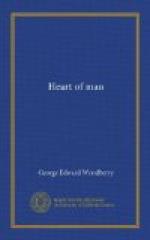Out of these changes of time, in response to the varying moods of men in respect to the world they inhabit, arise those phases of art which are described as classical and romantic, words of much confusion. It has been attempted to distinguish the latter as having an element of remoteness, of surprise, of curiosity; but to me, at least, classical art has the same remoteness, the same surprise, and answers the same curiosity as romantic art. If I were to endeavour to oppose them I should say that classical art is clear, it is perfectly grasped in form, it satisfies the intellect, it awakes an emotion absorbed by itself, it definitely guides the will; romantic art is touched with mystery, it has richness and intricacy of form not fully comprehended, it suggests more than it satisfies, it stirs an unconfined and wandering emotion, it invigorates an adventurous will; classicism is whole in itself and lives in the central region, the white light, of that star of ideality which is the light of our knowledge; romanticism borders on something else,—the rosy corona round about our star, carrying on its dawning power into those unknown infinities which embosom the spark of life. The two have always existed in conjunction, the romantic element in ancient literature being large. But owing to the disclosure of the world to us in later times, to the deeper sense of its mysteries which are our bounding horizons round about, and especially to the impulse given to emotion by the opening of the doors of immortality by Christianity to thought, revery, and dream, to hope and effort, the romantic element has been more marked in modern art, has in fact characterized it, being fed moreover by the ever increasing inwardness of human life, the greater value and opportunity of personality in a free and high civilization, and by the uncertainty, confusion, and complexity of such masses of human experience as our observation now controls. The romantic temper is inevitable in men whose lives are themselves thought of as, in form, but fragments of the life to come, which shall find their completion an eternal task. It is the natural ally of faith which it alone can render with an infinite outlook; and it is the complement of that mystery which is required to supplement it, and which is an abiding presence in the habit of the sensitive and serious mind. Yet in classical art the definite may still be rendered, the known, the conquered. Idealism has its finished world therein; in romanticism it has rather its prophetic work.
Such, then, as best I can state it in brief and rapid strokes, is the world of art, its methods, its appeals, its significance to mankind. Idealism, so presented, is in a sense a glorification of the commonplace. Its realm lies in the common lot of men; its distinction is to embrace truth for all, and truth in its universal forms of experience and personality, the primary, elementary, equally shared fates, passions, beliefs of the race. Shakspere, our great example, as




